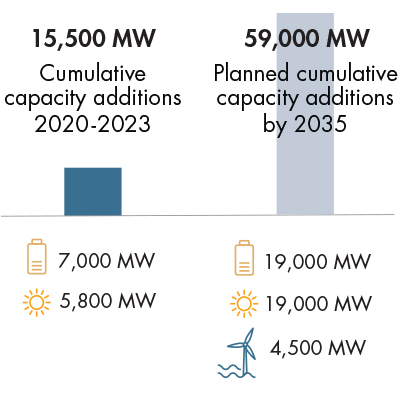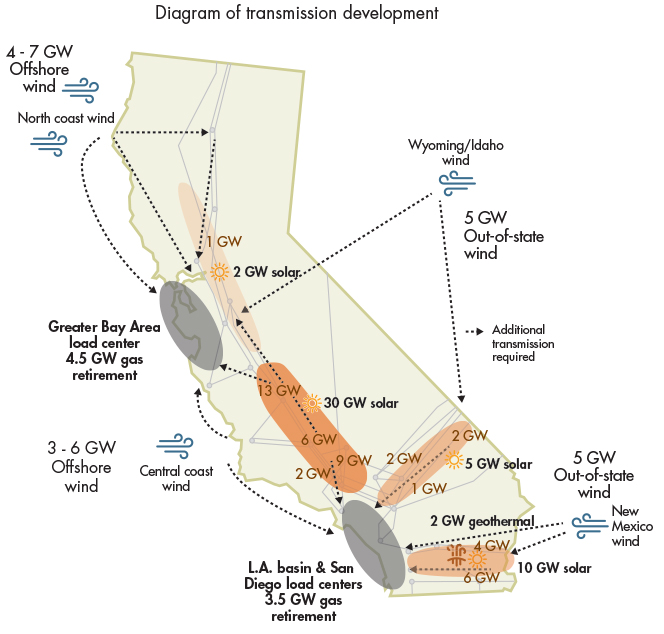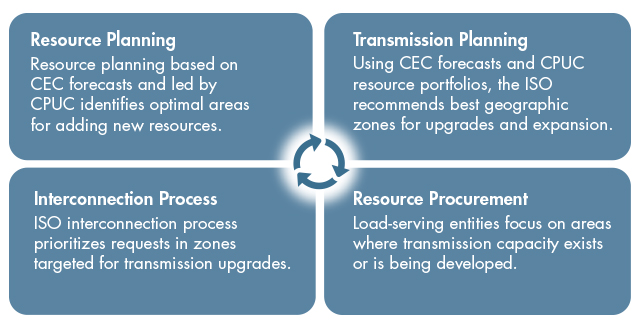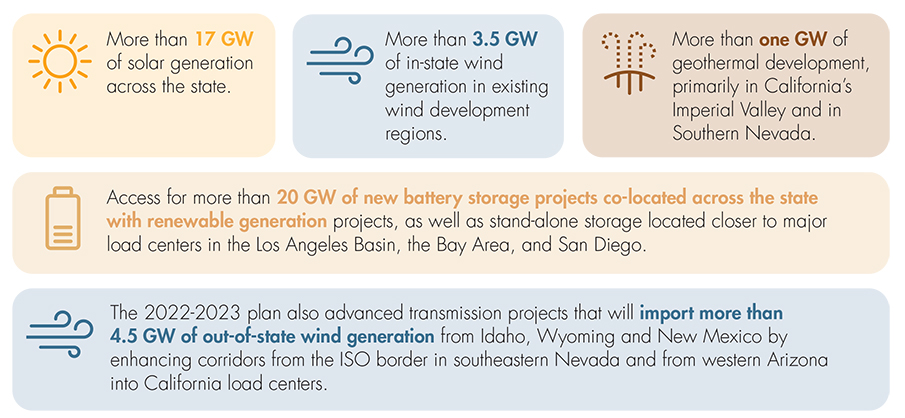< Back to blog
Taking the Long View: The ISO’s Collaborative Approach to Transmission Planning & Coordination
April 25, 2024
A commonly heard refrain during these transformational times in the power industry is “No transition without transmission.” Indeed, the urgent need to provide additional transmission infrastructure to meet the rising demand for electricity and onboard new resources quickly and cost-effectively is a growing concern throughout the West and much of the nation. It is now well understood that major transmission upgrades can take a decade or more to plan, finance, build and connect to the system.
In California, where the state has dramatically accelerated the pace for integrating new clean resources onto the grid, the California Independent System Operator (ISO) is working collaboratively and creatively with state agencies, utilities and other key stakeholders to ensure sufficient transmission to deliver that power to consumers. At the same time, the ISO is collaborating with partners around the region to improve interconnectivity and share diverse resources to meet energy policy objectives.
 In just the past four years, the ISO has integrated more than 15,000 megawatts (MW) of new resources onto the grid. And by this summer, battery storage assets on the system will reach about 10,000 MW – a critical tool in achieving resource adequacy goals and maintaining grid reliability during extreme heat and wildfires. But as the chart on this page illustrates, we must sustain and even exceed this pace of resource integration for many years to come. To that end, the ISO and our partners have taken a number of steps to stay apace with clean-energy goals while addressing grid resiliency and affordability.
In just the past four years, the ISO has integrated more than 15,000 megawatts (MW) of new resources onto the grid. And by this summer, battery storage assets on the system will reach about 10,000 MW – a critical tool in achieving resource adequacy goals and maintaining grid reliability during extreme heat and wildfires. But as the chart on this page illustrates, we must sustain and even exceed this pace of resource integration for many years to come. To that end, the ISO and our partners have taken a number of steps to stay apace with clean-energy goals while addressing grid resiliency and affordability.
A central element of our strategy has been to work with state agencies to extend the planning horizon for transmission upgrades. And we have been working closely with local and state regulatory authorities and load-serving entities to more tightly synchronize power and transmission planning, interconnection queuing and commercial procurement of additional resources. This blog post provides an overview of our new, more coordinated and synchronized approach and a summary of some of the benefits that have been realized through enhanced collaboration.
Longer-term planning horizons enable alignment with policy objectives
In the past, as part of its core responsibility to identify and shape solutions that meet the future needs of the transmission grid, the ISO worked with stakeholders to develop an annual plan for infrastructure upgrades spanning a 10-year time frame. That collaborative process still results in an annual plan sent to the ISO’s Board of Governors, typically in May, for approval of specific projects.
 But now, driven by the evolving resource mix and the state’s clean-energy goals that require adding between 7,000 and 8,000 megawatts (MW) of new power to the system for each of the next 20 years, the ISO and its partners have been thinking more long-term and proactively about future infrastructure requirements.
But now, driven by the evolving resource mix and the state’s clean-energy goals that require adding between 7,000 and 8,000 megawatts (MW) of new power to the system for each of the next 20 years, the ISO and its partners have been thinking more long-term and proactively about future infrastructure requirements.
In May 2022, working closely with the California Public Utilities Commission (CPUC), California Energy Commission (CEC) and members of the energy industry, the ISO
published its first 20-Year Transmission Outlook. This macro analysis mapped the broad architecture of California’s future transmission network. It also helped clarify our vision and the magnitude of the challenge in building major pieces of infrastructure – inside and outside the state – necessary for California to achieve the carbon-free grid envisioned by 2045 under
Senate Bill 100, which was signed into law in 2018.
The 20-Year Outlook identified the need for approximately $30 billion in infrastructure investments over the next two decades to reinforce the backbone of the California grid, as well as support offshore wind and access to out-of-state renewables. The Outlook is currently being updated and is scheduled for release later this spring.
A new paradigm for transmission
The California Energy Commission estimates that to meet increasing load growth from electrification of other energy sectors, make up for the retirement of aging power plants and decarbonize the grid, the State will need about 165 gigawatts (GW) of new installed capacity by 2045. That is more than double the approximately 80 GW of current installed capacity. This will include solar resources, wind, and storage that together can help meet peak load. The forecast also accounts for the need to onboard new carbonfree generation to charge batteries to meet demand when energy is not available from variable wind and solar resources.
A transformation of this magnitude requires deeply collaborative, efficient and closely coordinated planning and execution. The old way of incrementally expanding the system is no longer sufficient to keep pace with future growth or all the change taking place.
In December 2022, the ISO, CPUC and CEC signed an updated Memorandum of Understanding to ensure that resource and transmission planning, procurement of new resources, and interconnection processes are tightly linked and synchronized. To successfully plan, select, finance, build and onboard historic amounts of new resources and transmission in a timely and efficient manner, these processes must be thought of as virtually one continuous set of coordinated actions.
As part of the more synchronized processes codified in the December 2022 agreement, the CPUC will provide clear direction to load-serving entities to procure to meet the state’s reliability and greenhouse gas-reduction needs and, to the appropriate extent, focus energy procurement in key transmission zones aligned with the CPUC’s integrated resource plan process that informs the ISO transmission plans. And the ISO, in its proposed generator interconnection process reform, will give greater priority to interconnection requests located within those same transmission zones.

Turning ideas into action
Translating this new paradigm into concrete action, the
ISO Board of Governors in May 2023 approved a 2022-2023 transmission plan recommending 45 new infrastructure projects that would be built by utilities, independent transmission developers and other partners. Among other things, the plan identified additional transmission and resource capacity associated with designated geographic zones that align with state and local resource plans, and make the most economic and operational sense for such development.
The total cost of these new projects over the 10-year timeframe of the May 2023 plan is an estimated $7.3 billion, a first round of investment towards needs identified in the 20-Year Outlook. These costs translate to less than a half cent per kilowatt-hour over the life of the projects, phased in as new facilities come online. It is important to note, however, that the rate design processes between utilities and regulators determine how these costs are ultimately allocated among customer groups and how they are recovered through utility rates from end-use consumers.

Some of the major projects approved include:
- A new 500 kV transmission line running west from the Arizona border into southern Imperial County.
- New 500 kV transmission lines angling up from southern Imperial County to northern San Diego and extending into the southern Los Angeles Basin.
- Upgrades to the existing 500 kV and 230 kV lines along the Interstate 10 corridor. • Together, these upgrades provide access to east Riverside County, Imperial County and Arizona solar generation, Imperial Valley geothermal, and New Mexico wind generation.
- Upgrades to the Lugo–Victor–Kramer 230 kV transmission system to access north of Lugo solar resources.
- A host of smaller upgrades improving access to other smaller resource zones.
In addition to helping meet load growth and increasing access to renewable generation, a number of these projects will also reduce the need for gas-fired generation in certain areas of the state.
Also, the ISO’s 2023-2024 draft transmission plan posted April 1, 2024 identified 26 new transmission projects. The projects, which include the first transmission needed to bring wind energy from the North Coast onto the ISO grid, are consistent with the CPUC’s Integrated Resource Planning (IRP) process that sets targets for procurement and greenhouse gas reductions and informs future transmission approvals.
New imperatives give rise to creative solutions
Although a significant amount of new resource development over the next twenty years will occur within California or in zones designated for offshore wind, resource and transmission planning portfolios and growing load forecasts from the state also triggered creative solutions to access out-of-state resources. One such solution is the
Subscriber Participating Transmission Owner (SPTO) model.
The SPTO model, which was approved by the Federal Energy Regulatory Commission (FERC) on March 12, 2024, will enable new transmission lines outside the ISO balancing area to connect generation to the California grid, placing the transmission facilities under ISO operational control. Under this innovative approach, entities subscribing to use the transmission line help finance the up-front cost of the project without increasing the ISO’s transmission access charge. Individual load-serving entities across the West will then have the opportunity to sign long-term contracts for renewable energy delivered from these projects.
TransWest Express and SunZia, two major transmission lines that will bring clean energy into California and the Desert Southwest from Wyoming and New Mexico, strengthening regional interconnectivity and reliability, have each applied as subscriber PTOs. The ISO Board has already approved TransWest Express; SunZia is scheduled to go to the Board for consideration in May.
TransWest Express is a 732-mile combined high-voltage direct and alternating current transmission line with the potential to bring up to 3,000 MW of clean Wyoming wind power into California and other states in the Desert Southwest as early as 2027.
The SunZia project is a 550-mile line between central New Mexico and south- central Arizona that will have the capacity to transport 3,000 MW of wind energy to California and neighboring states.
Also, in December 2023, the ISO Board of Governors conditionally approved the
Southwest Intertie Project – North transmission line. This 285-mile link to an existing transmission pathway will deliver Idaho wind to California and the Southwest. If approved by the Idaho Public Utilities Commission as part of Idaho Power’s upcoming Integrated Resource Plan, the project will also enable the utility to import additional energy into its system. These transmission lines will expand the ISO’s access to critically needed regional resources and create benefits for multiple parties, including regional utilities and independent power and transmission developers. The subscriber transmission model also provides an alternative to the complex cost-allocation policies that have slowed development of other interregional transmission infrastructure.
Interregional transmission is a key component of building resilience and ensuring reliability across the West. As we continue to take steps to improve connectivity throughout the region and work with neighboring states and balancing areas, the ISO is also participating in emerging regional discussions, such as the
Western Transmission Expansion Coalition (WestTEC) and the Committee on Regional Electric Power Cooperation (CREPC) Transmission Collaborative to inform and accelerate actionable West-wide transmission planning.
1. S-Line Project
Developer: Imperial Irrigation District (IID) and Citizens Energy
Status: Under construction
Expected in-service date: 2024
Generation enabled: Reduces deliverability limitations in addition to economic benefits
Partnership/benefits: Enables increased bi-directional delivery of supply to IID as well as renewable supply from IID to the ISO. Decreases local requirements in San Diego and Imperial Valley area.
2. Ten West Project
Developer: Lotus Infrastructure Partners
Status: Under construction
Expected in-service date: May 2024
Generation enabled: 1000 MW of renewables in Imperial Valley, Palo Verde trading hub
Partnership/benefits: Enables additional renewables from Southwest to the ISO as well as increased export capability to the Southwest.
3. TransWest Express
Developer: TransWest Express LLC, subsidiary of Anschutz Corp.
Status: Construction started Sept. 2023
Expected in-service date: 2027
Generation enabled: 3000 MW of Wyoming wind
Partnership/benefits: Enables partnership with entities engaged with west-wide development/procurement activity.
4. Sunzia
Developer: Pattern Energy
Status: Construction started July 2023
Expected in-service date: 2026
Generation enabled: 3,500 MW of New Mexico wind
Partnership/benefits: Enables access to New Mexico wind by California and Southwest load serving entities.
5. Southwest Intertie Project - North (SWIP-N)
Developer: LS Power
Status: Conditionally approved as addendum to 2022-2023 Transmission Plan by CAISO Board Dec. 2023
Expected in-service date: End of 2026
Generation enabled: 2000MW of Idaho wind
Partnership/benefits: Enables partnership providing mutual benefits to and from Idaho and California while also providing additional transfer capability from Northwest to Southwest entities.
Improving the interconnection process
Efficient onboarding of such large amounts of new resources requires an interconnection process that facilitates identification and pursuit of potential projects that meet actual, identified resource needs of load-serving entities. To adapt to the increased need and competition for new resource interconnections, the
ISO’s Infrastructure and Operations Planning team has spent more than a year in deep engagement with stakeholders. The stakeholder engagement process included defining problems and principles, and exploring stakeholder proposals as fundamental elements of the reformed process.
 Among other things, the ISO is working to shift the interconnection request process from one that is currently used to gather information in the early stages of project development to one that requires greater investment in and advancement of generation projects prior to the interconnection request application window.
Among other things, the ISO is working to shift the interconnection request process from one that is currently used to gather information in the early stages of project development to one that requires greater investment in and advancement of generation projects prior to the interconnection request application window.
Only the most advanced and commercially viable projects would move to the study process under the proposed new procedures. This will result in more meaningful study results and greater efficiency for the ISO and transmission owners involved in completing the studies.
The ISO is working with stakeholders to keep the process efficient and progressive, with the goal of moving commercially viable projects toward completion and creating clearer milestones for projects that fail to demonstrate continued and consistent progress in the interconnection queue. And, as stated earlier, under its proposal to reform the generator interconnection process, the ISO will give greater priority to interconnection requests located in key transmission zones that align with integrated resource plans that inform the ISO transmission plans.
We are committed to bringing new, approved, and necessary transmission resources into service as soon as possible to ensure reliability and an affordable pathway to achieving policy objectives. The ISO anticipates presenting a comprehensive and transformational proposal to the ISO Board of Governors in May.
Use of grid-enhancing technologies and consideration of alternatives
The ISO’s annual transmission plan also includes a comprehensive analytical screening of hundreds of options and detailed assessments of alternatives that consider transmission upgrades, preferred resources such as storage, grid-enhancing technologies (GETs), and remedial action schemes.
GETs encompass a range of technologies such as flow controllers and advanced conductors that provide specific benefits and opportunities to minimize congestion on the system and provide access to renewable resources. Policymakers are rightfully examining and encouraging accelerated deployment of GETs as cost-effective opportunities to increase grid capacity. FERC Order 2023 requires transmission providers to consider opportunities to deploy GETs in the resource interconnection process. Other grid-enhancing technologies, including dynamic thermal line ratings and dynamic system optimization, can also provide operational savings, and the ISO, pursuant to FERC Order 881, is implementing ambient adjusted ratings.
The ISO has considered the use of GETs – primarily advanced conductors and flow controllers – in the annual transmission planning process for many years and examines specific applications on a case-by-case basis to ensure reliability, safety, and cost-effectiveness. Flow controllers have to date been more successful. Examples include the Imperial Valley phase shifting transformer, high voltage direct current flow control via two projects under development in San Jose, multiple uses of reactors and Smart Wires technology and various other grid-enhancing technologies, including, among others, synchronous condensers and series capacitors. Advanced conductors have also been employed by participating transmission owners in capital maintenance programs.
The ISO also recently approved a transmission expansion project utilizing advanced conductors on four circuits of approximately ten miles each that are part of the bigger Lugo-Victor-Kramer 230 kV upgrade project in San Bernardino County.
 Managing costs of infrastructure development
Managing costs of infrastructure development
The ISO recognizes and appreciates concerns regarding the impacts on ratepayers of capital projects identified and approved in the ISO’s planning process. We will continue to work with utilities, independent developers, stakeholders and state agencies to explore cost-effective solutions to meeting long-term needs in current and future planning cycles. As a non-profit 501(c3) public benefit corporation, our sole motivation is to provide the most cost-effective transmission solutions to meet policy, reliability and economic objectives.
The approved transmission projects mentioned in this summary will generate billions of dollars in economic activity and increase interconnectivity and coordination throughout the Western U.S. The more the West is interconnected and working together to efficiently move diverse resources where and when energy is needed, the more reliable the entire Western Interconnection will become.
Of course, there are many variables that come into play when working to advance major infrastructure projects, including permitting, siting, access to capital, supply chain management and more. But the ISO looks forward to continuing to work with industry, policymakers and others to make sure we are doing everything in our power to advance creative solutions to transmission planning, subscription and energization. Along with a more proactive, collaborative and coordinated approach to planning for the long and short term, we are committed to helping California and the West bring online the infrastructure needed to meet the growing demand for clean power and achieve a reliable and affordable energy transition for the people we serve.
Find a PDF version of this blog story here.